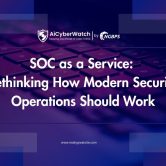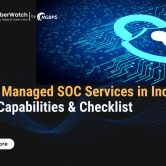Introduction: The New Convergence Frontier
In today’s hyperconnected world, Operational Technology (OT) is no longer operating in isolation. As enterprises digitize legacy infrastructure to enhance performance, cut costs, and enable real-time monitoring, IT and OT environments are converging rapidly. This convergence, while essential for modernization, is also introducing unprecedented cybersecurity risks.
For industries such as energy, manufacturing, pharmaceuticals, and defense, where industrial control systems (ICS) govern critical processes, any compromise can lead to catastrophic outcomes — from production halts to national security breaches.
This guide explores how CISOs, Heads of OT Operations, CIOs, and Risk Officers can tackle the complex security challenges of IT/OT convergence with a unified, proactive, and risk-aligned approach — with AiCyberWatch and OPSWAT at the helm of this secure transformation.
Section 1: Understanding OT/IT Convergence
What is OT/IT Convergence?
IT (Information Technology) focuses on data, applications, and user systems — email, databases, enterprise software.
OT (Operational Technology) governs the physical processes — SCADA systems, PLCs, DCS, sensors, and industrial equipment.
Convergence means the integration of data and systems between IT and OT to allow for seamless monitoring, analytics, decision-making, and automation.
Why It’s Happening:
-
Digital transformation of industrial assets (Industry 4.0)
-
Cloud adoption and remote operations
-
The need for predictive maintenance and AI-driven analytics
-
Increased pressure to reduce operational costs
Section 2: The Security Challenges of Convergence
1. Legacy Systems with No Security by Design
Many OT environments still run on outdated protocols and legacy systems that were never intended to connect to external networks — let alone the internet.
2. Lack of Visibility and Control
Security teams often lack real-time visibility into OT assets and their communication patterns. Blind spots in asset inventory create massive risks.
3. Expanded Attack Surface
Merging IT and OT extends the attack surface, making it easier for ransomware or state-sponsored actors to pivot from IT networks into critical OT infrastructure.
4. Cultural & Operational Silos
IT and OT teams operate with different priorities. While IT emphasizes confidentiality and uptime, OT focuses on safety and availability. These differing KPIs often cause friction during security policy implementation.
5. Compliance Complexities
CISOs must navigate a web of overlapping regulations — from NIST, IEC 62443, GDPR, to sector-specific mandates — all while managing cyber risk.
Section 3: Key Pillars of OT/IT Convergence Security
1. Asset Discovery & Inventory Management
-
Deploy agentless technologies to auto-discover every IT and OT asset.
-
Use OPSWAT MetaDefender and OT-native asset discovery tools for full visibility.
2. Network Segmentation and Microsegmentation
-
Segment IT and OT networks using firewalls, VLANs, and zero trust access controls.
-
Use Unidirectional Security Gateways or Data Diodes for one-way communication where necessary.
3. Patch Management Without Downtime
-
Legacy OT systems often can’t afford downtime.
-
Implement virtual patching and compensating controls until scheduled maintenance.
4. Deep Content Inspection (DCI) for OT File Transfers
-
With USB drives and manual file transfers still common in OT, ensure air-gapped systems are protected using DCI and multi-layered malware scanning via OPSWAT technologies.
5. Access Control & Identity Management
-
Enforce role-based access, multi-factor authentication (MFA), and least privilege principles for both IT and OT systems.
6. Continuous Monitoring and Threat Detection
-
Deploy OT-aware SIEMs and anomaly detection tools capable of understanding proprietary protocols.
-
Leverage Hyperautomated Autonomous SOC Services from AiCyberWatch for 24/7 response.
7. Security Awareness & Cross-Team Collaboration
-
Train both IT and OT personnel on convergence-related threats.
-
Break silos by forming cross-functional security governance teams.
Section 4: Building a Unified Security Strategy
Step 1: Perform a Converged Risk Assessment
-
Identify business-critical OT systems and assess how their compromise affects enterprise risk.
-
Use threat modeling specific to industrial environments (e.g., MITRE ATT&CK for ICS).
Step 2: Prioritize Based on Impact & Exposure
-
Not all OT systems have the same level of exposure. Prioritize Internet-facing, remote-accessible, and mission-critical assets first.
Step 3: Integrate IT/OT Security Tools
-
Bridge the gap between traditional IT tools and OT requirements using OPSWAT’s industrial-grade cybersecurity platform.
Step 4: Simulate & Test with Tabletop Exercises
-
Conduct incident response simulations involving both IT and OT teams to evaluate readiness and identify gaps.
Section 5: How AiCyberWatch & OPSWAT Secure Your Convergence Journey
As an Authorized Partner of OPSWAT, AiCyberWatch delivers specialized expertise in critical infrastructure protection and industrial-grade cybersecurity.
Our Capabilities:
-
✔️ Industrial File Sanitization (CDR)
-
✔️ Deep Content Inspection for OT environments
-
✔️ Portable Media Security Gateways
-
✔️ Hyperautomated Autonomous SOC Services
-
✔️ IT/OT Security Assessment & Compliance Roadmaps
We’ve helped enterprises in energy, defense, pharmaceuticals, and smart manufacturing transition safely into a connected future — without compromising availability, compliance, or safety.
Conclusion: Futureproofing Your OT/IT Convergence
The path to convergence is inevitable — but not inherently secure. As cyber threats evolve and target the weakest links, securing the convergence of IT and OT systems must become a strategic priority for every forward-looking CISO and OT leader.
With the right frameworks, technologies, and partners like AiCyberWatch and OPSWAT, organizations can ensure that digitization and protection go hand-in-hand.




